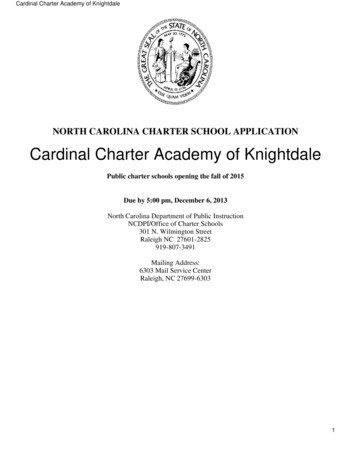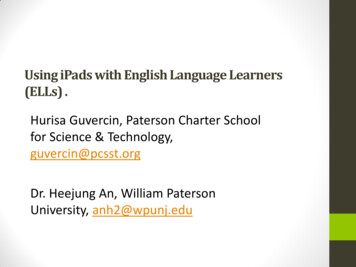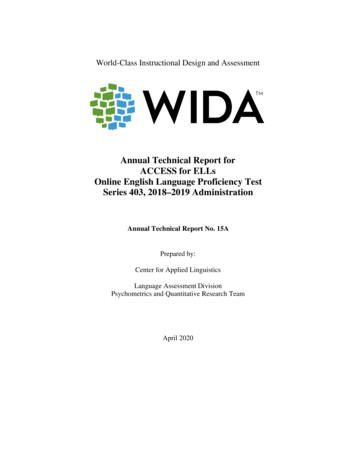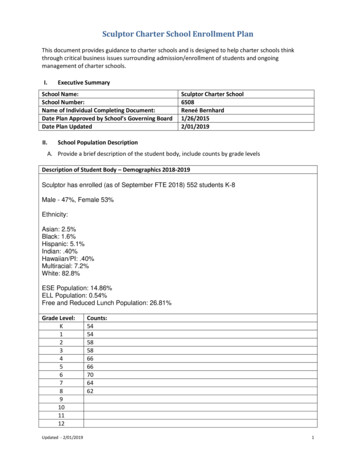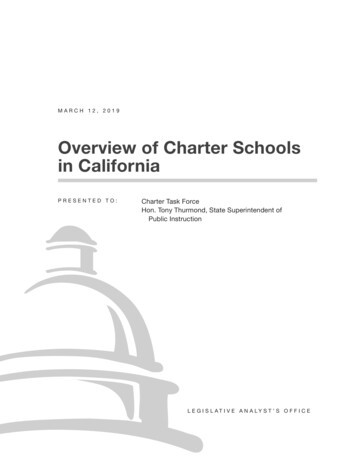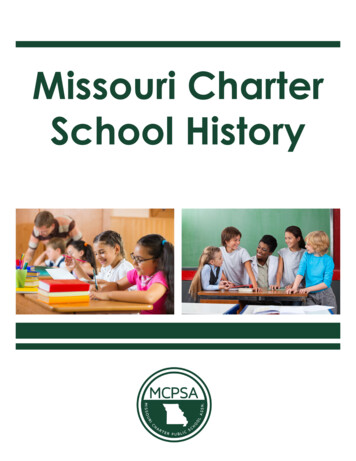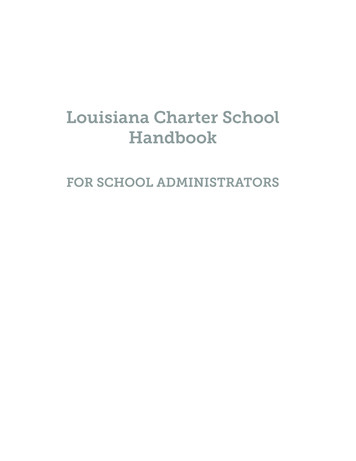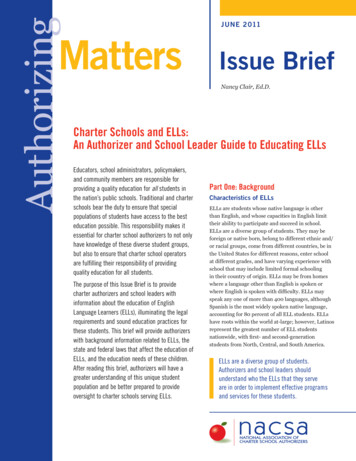
Transcription
JUNE 2011Nancy Clair, Ed.D.Charter Schools and ELLs:An Authorizer and School Leader Guide to Educating ELLsEducators, school administrators, policymakers,and community members are responsible forproviding a quality education for all students inthe nation’s public schools. Traditional and charterschools bear the duty to ensure that specialpopulations of students have access to the besteducation possible. This responsibility makes itessential for charter school authorizers to not onlyhave knowledge of these diverse student groups,but also to ensure that charter school operatorsare fulfilling their responsibility of providingquality education for all students.The purpose of this Issue Brief is to providecharter authorizers and school leaders withinformation about the education of EnglishLanguage Learners (ELLs), illuminating the legalrequirements and sound education practices forthese students. This brief will provide authorizerswith background information related to ELLs, thestate and federal laws that affect the education ofELLs, and the education needs of these children.After reading this brief, authorizers will have agreater understanding of this unique studentpopulation and be better prepared to provideoversight to charter schools serving ELLs.Part One: BackgroundCharacteristics of ELLsELLs are students whose native language is otherthan English, and whose capacities in English limittheir ability to participate and succeed in school.ELLs are a diverse group of students. They may beforeign or native born, belong to different ethnic and/or racial groups, come from different countries, be inthe United States for different reasons, enter schoolat different grades, and have varying experience withschool that may include limited formal schoolingin their country of origin. ELLs may be from homeswhere a language other than English is spoken orwhere English is spoken with difficulty. ELLs mayspeak any one of more than 400 languages, althoughSpanish is the most widely spoken native language,accounting for 80 percent of all ELL students. ELLshave roots within the world at-large; however, Latinosrepresent the greatest number of ELL studentsnationwide, with first- and second-generationstudents from North, Central, and South America.ELLs are a diverse group of students.Authorizers and school leaders shouldunderstand who the ELLs that they serveare in order to implement effective programsand services for these students.
2Issue BriefThe Context of Schooling for ELLsELLs comprise one of the fastest-growing groups inthe nation, representing 10 percent of K–12 studentsand numbering approximately five million students.Nationwide ELL enrollment in public schools has increasedby 57 percent from 1995–2005. In 20 states, the size of theELL population has at least doubled during this period.ELLs can be found in schools across the United States;however, a vast majority of ELLs are located in California,Nevada, Arizona, Texas, Florida, Virginia, New Jersey, NewYork, and Illinois. Moreover, the ELL population variesfrom state to state, and even city by city. This diversitymakes it necessary for authorizers to understand thecomplexities of the student population to better serve ELLs.As a group, ELLs have not reached their full potential inschool. In 2007, only 16.9 percent of students were foundto be proficient in English, and more than half were foundto be “not proficient” or “not making progress” on theirstate’s English-language proficiency tests.1 Many ELLsmake academic progress in the primary grades, but theirperformance frequently begins to drop around fourthgrade, when cognitive and academic demands requirehigher levels of comprehension and engagement withacademic material. ELL performance is lower than thatof other subgroups, and the achievement gap betweenELL and non-ELL students has remained. Finally, ELLsare more likely to drop out of school than their Englishspeaking peers.Charter Schools and ELLsAs the ELL school-age population increases, the number ofcharter schools is also growing at a rapid pace. As of 2009,there were more than 5,000 charter schools educatingmore than 1.5 million children; 419 new charter schoolsopened for the 2009–2010 school year. Charter schoolsplay an important role in educating ELLs, as many of theseschools serve a majority of at-risk, minority, and poorstudents. Data from the National Center for EducationStatistics’ School and Staffing Survey suggests that 16.5Authorizing Matters Issue Briefs are a publication of the NationalAssociation of Charter School Authorizers (NACSA), the trustedresource and innovative leader working with public officials andeducation leaders to increase the number of high-quality charterschools in cities and states across the nation. NACSA providestraining, consulting, and policy guidance to authorizers andeducation leaders interested in increasing the number of highquality schools and improving student outcomes.Visit us at www.qualitycharters.orgpercent of charter school students are ELLs, althoughsome argue that this data is incomplete.2 Furthermore,the Obama administration is relying on charter schoolsas one strategy to help turn around the approximately5,000 schools in most need of improvement. Thesetargeted schools serve Latinos and ELL studentsdisproportionately. Regardless of whether charter schooloperators choose to take on the turnaround challenge,they will continue to play a role in educating the growingnumbers of ELLs that demographic trends suggest.The independent and innovative nature of charter schoolslend these education providers the flexibility to servethe ELL population. Although research related to ELLacademic performance and charter schools is mixed,some programs are experiencing a great deal of success.For example, a recent 16 state study shows that ELLs inCalifornia charter schools are outperforming their peers intraditional public schools in reading and math.3 Anotherstudy of 22 KIPP middle schools found that KIPP studentshad statistically significant higher achievement in readingand math state assessments than did their non-KIPPpeers.4 These studies reveal the potential of charter schoolsin the education of ELLs. Other programs, however, arenot experiencing great success in educating ELLs, withtheir academic performance levels falling well behindthose of their peers in traditional public schools.Charter schools are agents of school choice, providingquality educational opportunities to all students. In orderto achieve this mission, they must be equipped to serveunique student groups such as ELLs. Authorizers areresponsible for ensuring that charter school applicants andoperators have a plan in place to educate ELLs.Part Two: The Law and ELLsFederal Civil Rights Laws and ELLsTitle VI of the Civil Rights Act of 1964 provides broadprotection for ELLs, ensuring equal access to education.The act states, “No person in the United States shall, onthe grounds of race, color, or national origin, be excludedfrom participation in, be denied benefits, or be subjectedto discrimination under any program or activity receivingfederal assistance.” Since 1964, federal laws and policiesregarding ELLs have evolved to ensure that states are incompliance and ELLs are receiving a quality education.Highlights include: In 1970, the Office of Civil Rights (OCR) issued a memoentitled “Identification of Discrimination and Denialof Services on the Basis of Nation Origin,” regardingschool districts’ responsibilities under civil rights laws
Issue Briefto provide equal educational opportunity for ELLs. Thememo states that school districts must take affirmativesteps to ensure that ELLs are not excluded from activeparticipation in educational programs. The OCR memodid not prescribe the content of the affirmative steps;however, Title VI violations serve as a guide for whatstates must not do. Title VI violations include:–– Excluding students from active participation inschool because of their inability to speak andunderstand the language of instruction;–– Placing national-origin minority students in specialeducation inappropriately because of their lack ofEnglish skills;–– Designing programs for students lacking Englishproficiency that do not teach English as soon aspossible, or programs that operate as a dead-endtrack; or–– Not providing parents whose English is limited withschool notices or other information in a languagethey can understand. In the 1974 case Lau v. Nichols, the United StatesSupreme Court upheld the 1970 OCR memo as avalid interpretation of Title VI. The Supreme Courtstated that merely providing students with the sametextbooks, teachers, and curriculum is not sufficient fora meaningful education if students do not understandEnglish. In 1985 and 1991, the OCR issued documents thatexplain the relevant legal standards for OCR policyconcerning discrimination of national origin andthe provision of ELL services in public schools. OCRprocedures ensure that schools serve ELLs effectivelyand have significant relevance to charter schools. Theseprocedures include:–– Identifying students that need assistance;–– Developing a program that, in view of experts in thefield, has a reasonable chance for success;–– Ensuring that staff, curricular materials, andfacilities are in place and used properly;–– Developing appropriate evaluation standards andincluding program exit criteria for measuringstudent progress; and–– Assessing the success of the program and modifyingit where needed.3Application of Civil Rights Laws to CharterSchools: Recruitment, Admission, and OutreachAs public schools, charter schools should be mindful ofcivil rights obligations in the recruitment and admission ofstudents, and in outreach to parents and families.Charter school operators should recruit from all segmentsof the community that the school serves, includingstudents with disabilities and students of different racesand national origins. Charter schools may also targetsegments of the population that may otherwise havelimited opportunity to attend the school.Moreover, charter school operators should be attentiveto parents and community members who lack Englishlanguage proficiency. Outreach materials should betranslated into multiple languages, public informationmeetings should be conducted in languages other thanEnglish, or interpreters should be available to ensurethat all parents can reasonably participate in meetings.Moreover, once ELL students are admitted into theschool, parents should receive information (e.g., policies,calendars, and report cards) in a language and mannerthey understand.NCLB has enhanced schools’responsibility for tracking ELLprogress on academic contentand English language proficiency.No Child Left Behind Act (2001)The Elementary and Secondary Education Act of 1965and its amended act, No Child Left Behind (NCLB) of2001, address the needs of ELLs through Title III andTitle I. The goal of NCLB is for all students to read andperform mathematic skills at or above grade level by 2014.NCLB legislation has enhanced schools’ responsibilityfor the academic progress of ELLs by designating ELL asa subgroup for making adequate yearly progress (AYP).NCLB requires that states establish English languageproficiency standards that include the language necessaryto acquire academic content, as well as create assessmentsaligned with those standards.Title III of the act holds states accountable for ELLprogress in listening, speaking, reading, writing, andcomprehending English. This provision requires schooloperators to use English language proficiency standardsto create curricula and measure and report progress basedon these standards. It also mandates that schools shouldhave the appropriate staff capacity to effectively deliver
4Issue BriefEnglish language instruction to ELL students. Title I holdsstates accountable for ensuring that ELLs master the sameacademic content in reading, math, and science as donon-ELL students. This requires schools to create contentcurricula and materials that are appropriate for the ageand proficiency of ELLs, to measure and report progressin content areas, and to ensure there is staff capacity toeffectively deliver content instruction for ELLs.Charter school operators should make sure they arecomplying with Title I and Title III regulations underNCLB, which includes ensuring that ELLs have accessto appropriate English language and academic contentinstruction, and that ELL progress in English languageproficiency and academic content be measured and reported.Charter Schools have the freedomto innovate in creating effectiveprograms for ELLs, as long asstudents’ rights are safeguarded.Part Three: Effective Schools andPrograms for ELLsAs noted, federal civil rights laws require that ELLshave access to a quality education and are not deniedprograms and services because of their inability to speakor understand English. Civil rights laws do not prescribethe content of how states and charter schools do this,giving states and charter schools the flexibility to designprograms and educational opportunities for ELLs. As longas students’ rights are safeguarded, charter schools havethe flexibility to innovate and create effective programsand services for ELLs.In this section, features of effective schools and programsfor ELLs are presented. These features represent soundeducational practice for ELLs and overlap with soundeducational practice for all students. For a description ofeffective charter schools that are showing results for ELLs,refer to the article, Next Generation Charter Schools:Meeting the Needs of Latinos and ELLs.5Features of Effective Schools for ELLsOverall, many of the attributes of effective charter schoolsalso support ELL achievement. However, researchers andeducators have learned much during the past decadesabout how best to teach the diverse ELL students thatpopulate public schools. Charter school leaders shouldhave up-to-date knowledge of the education of ELLs anda comprehensive system of schooling that includes thefollowing elements.6High-quality and Accessible Preschool EducationFor ELLs, these programs can reduce inequities andpervasive achievement gaps among groups of students.These programs should be culturally and linguisticallyresponsive, contain a developmentally appropriate andlanguage-rich curriculum as a basis for literacy andconceptual learning, build upon children’s home language,and be parent and family friendly to increase parentalengagement with their child’s early education.Comprehensive Program of English Language Development(ELD) that Supports Academic DevelopmentELLs need a standards-based, developmentallyappropriate program that promotes English language andacademic content development. An ELD program should: Actively develop all domains of language, includinglistening, speaking, reading, and writing skills, ensuringthere is meaningful oral language development forbeginning students; Address different levels of English language proficiencyand fluency; Develop age- and context-appropriate language skills,including a focus on academic English; Provide meaningful opportunities for ELLs to interactwith English-speaking peers; Foster a supportive classroom and school environmentfor language learners; and Recognize the role of a student’s native languagein ELD.Comprehensive Program of Academic Content—Access tothe Academic CurriculumWhile ELLs are learning English, they need access to awell-articulated, age-appropriate academic curriculum.Charter operators can select from a number of programalternatives that are presented in the next section of thisIssue Brief. The selection of these programs dependson the type of ELL student served by the program,the composition of students in a particular school, thegoals of the school, and the capacity of the school staffto successfully deliver the program. The success ofthe program is linked to the consistency and depth ofimplementation.High-quality Instruction and MaterialsThe quality of instruction for ELLs is paramount. Aneffective teacher that has a basic understanding of howELLs acquire English and academic content is perhapsthe greatest determiner of ELL success. ELLs with
Issue Briefsufficient English can access grade-level curricula inEnglish if teachers know how to differentiate instruction,make the content comprehensible, and have resourcematerials in the home language that students can use toassist in comprehension. Ways to make academic contentcomprehensible include, but are not limited to, buildingupon students’ prior knowledge, providing explicitinstruction in learning strategies, and using visual andcontext clues.Valid, Reliable, and Fair AssessmentsEffective instruction, decision making, and publicaccountability rely on valid, reliable, and fair assessmentsthat measure student performance. For ELLs, progressmust be measured for both English language proficiencyand academic content growth. Effective schools makedata-based decision making a habitual part of professionaldevelopment. This necessitates administrators andteachers who understand how to use different assessmentdata for ELLs, have access to timely and useful data, andare supported with training to make instructional andother decisions that are based on the data.School-wide Commitment to ELLs’ Academic, Intellectual,and Social GrowthELL students’ academic, intellectual, and social growthdepend on a strong commitment from the entire schoolcommunity. Staff members take responsibility for ELLstudent success, and their roles and responsibilities areclear. A school-wide commitment contains, but is notlimited to, the following features: An inclusive environment where ELLs feel safe andwhere teachers know how to build on their students’cultural capital; High expectations, where all staff demonstrate thatELLs have the capacity to achieve academically,intellectually, and socially; Shared responsibility, where the education of ELLsis not the sole responsibility of the ELL teacheror department, and all staff understand theirresponsibility in supporting the education of ELLs; and High-quality professional development and collaboration,where professional development is linked tostudent results and where all teachers have a basicunderstanding of second-language development andthe nature of language proficiency, the role of the firstlanguage and culture in learning, the demands that thegeneral-education classroom places on ELLs, and how touse assessment data to make instructional decisions.5Strong Family and Community PartnershipsELLs achieve high levels of academic and social successin schools where there is active parent, family, andcommunity involvement. Like ELLs, their parents are adiverse group; they may be confronted with social andcultural challenges, speak a language other than English,work long hours, and be unfamiliar with schoolingprocedures in the United States. Other ELL parents mayspeak English, have experience as community activists,and be quite familiar with U.S. schools. Therefore,school leaders need to know their parent community andstructure parent involvement that is inclusive, buildspartnerships, educates, and exchanges information withparents. The following are example strategies that supportthe creation of effective parent involvement. Translate all materials in the languages that parentsspeak and provide interpreters at school meetings Conduct school meetings in the community Create meaningful volunteer opportunities for parents Provide multiple ways for family involvement (e.g.,school events, family nights, and school celebrations) Conduct home visitsELLs need charter school leaders withcurrent expertise in the education of ELLsand a comprehensive system of schoolingthat holds high expectations for theiracademic and social success.Consistent Support and Flexible StructuresELLs confront academic and social challenges that arerelated to their life circumstances. Academically, ELLsmust not only master academic content, but also learnEnglish. Socially, ELLs may need to work, assist in caringfor siblings or parents, and migrate to other states or theirhome countries during the school year. These challengescan be alleviated by structuring schools in new ways andproviding ELLs with more time to accomplish goals. Charterschools are well situated to do this. Strategies for increasingtime include extended day programs, summer intensiveprograms, night school, and year-round enrollment. In theelementary grades, schools can implement looping, thusproviding teachers with more time to build relationshipswith ELLs and their families. In secondary schools, blockscheduling allows teachers longer periods with fewerstudents, thus facilitating stronger relationships withELLs and implementing more in-depth teaching, such asprojects and student research. In addition, small learning
6Issue Briefcommunities or advisory groups facilitate a degree ofpersonalization among teachers and ELLs. Effectivestrategies to alleviate ELL social challenges includeindependent study, computerized courses, and curricularunits that ELLs can do outside of the normal school day.Access to Expertise and Increased Capacity to Serve ELLsCharter school leaders and teachers need significantknowledge and skills to provide quality programs andservices for ELLs. Minimally, charter school leaders needexpertise or access to expertise in selecting, adapting,implementing, and monitoring appropriate programs andservices for ELLs, recruiting and retaining qualified staff,and providing ongoing professional development on theeducation of ELLs. Teachers must teach and assess ELLsin ways that reflect a basic understanding of the factorsthat influence second-language development, the role ofthe first language in learning a second language, and thedemands of the academic curricula. In addition, they mustbuild relationships with ELLs and these students’ families.In evaluating charter school applications, authorizersshould be mindful of the potential operator’s plan toserve ELLs. The National Association of Charter SchoolAuthorizers’ (NACSA) Principles & Standards for QualityCharter School Authorizing states that a quality authorizerensures that schools provide access and appropriatelyserve special populations of students, including ELLs,homeless students, special-education students, and giftedstudents as required by state and federal law. Additionally,authorizers should ensure that virtual/online charterschools provide appropriate services in virtual learningenvironments for ELLs and students with disabilities.When evaluating a charter school applicant or reviewingan existing charter school operator, authorizers shouldconsider the school’s recruitment and communicationsplans regarding ELLs, the academic performance of ELLs,the existence of English language development programsand academic content, and the use of effective tools toassess the progress of ELLs.Program Model/Alternatives for ELLsIn addition to creating effective schools, charter schoolleaders have the flexibility to select and/or adaptappropriate program models and alternatives that ensureELL academic success. There are a number of researchbased models that are being applied in successful charterschools, and there is a wealth of information for charterleaders to access to help build effective programs for ELLs.ELLs are a diverse group of students with varying needs.The academic levels of ELLs include under-schooledstudents, newly arrived higher educated adolescents, andlong-term ELLs who have been in the United States morethan six years. No program model fits all ELL studentsand circumstances; charter operators should first fullyunderstand the ELL populations they serve in order toselect or adapt the most appropriate program. Oncethe program is selected, it should be implemented withconsistency and fidelity, and monitored to ensure thatELLs are making English language and academic progress.The research-based programs presented include a rangefrom all English to bilingual programs. They includesheltered instruction (SI); structured English immersion(SEI); newcomer, transitional, and bilingual education(TBE); developmental bilingual education; and two-way/dual languages. Each program model has goals, servesstudents with different characteristics and grade levels,requires varying teacher skills and qualifications, andincludes instructional materials consistent with thelanguage of instruction.While these programs are different, they share the needfor charter school operators’ expertise in selection,implementation, and monitoring efforts. It is beyond thescope of this brief to describe each program model andalternative in detail. However, Table I gives a snapshot ofthe characteristics of the different program models andalternatives for ELLs. For a full description and discussionof these program models, see Genesee, F. (Ed.) (1999)Program alternatives for linguistically diverse students.(Educational Practice Rep. No. 1) Santa Cruz, CA: Centerfor Research on Education, Diversity & Excellence,University of California and Washington, D.C.: Center forApplied Linguistics. This table provides authorizers withterms frequently used when discussing ELL education.Charter schools are vehicles for innovation in publiceducation; therefore, the actual programs that charterschool applicants and operators use will vary.ConclusionCharter schools are a viable and important educationaloption for the growing number of school-aged ELLs. Withthe growing population of ELLs in our nation’s publicschools, charter schools will continue to play an importantrole in educating this unique student group. This IssueBrief is designed to provide charter authorizers and schoolleaders with essential information on ELLs, including thefederal laws and regulations that protect them, featuresof effective schools, and research-based ELL programmodels and alternatives that can be replicated or adaptedin charter schools. It is the hope that charter authorizersand school leaders will use this information to provide aquality education for these students.
Issue Brief7Table I–Summary of Instructional Programs for ELLs7ShelteredInstruction (SI)StructuredEnglishNewcomerImmersion ucation (TBE) EducationTwo-Way orDual LanguageLanguage GoalsProficiencyin academicEnglishProficiencyin academicEnglishEnglishproficiencyTransition toall EnglishinstructionBilingualismBilingualismAcademic GoalsSame asEnglish-speakingpeersSame asEnglish-speakingpeersVariedSame asEnglish-speakingpeersSame asEnglish-speakingpeersSame asEnglish-speakingpeersEnglishProficiency/Student TypeLimited or noEnglishLimited or noEnglish/studentsspeak differentfirst language(L1)Limited or noEnglish/newlyarrivedLimited or noEnglish/studentsspeak same L1Limited or noEnglish/studentsspeak same L1Native Englishspeakers andstudents withlimited EnglishEntry Grade/Grades ServedAny grade entry/K–12 servedAny grade entry/K–12 servedK–12/mostcommon inmiddle and HSK–3 entry/K–3servedElementarygradesK–1 entry/K–8TeacherQualificationsTraining inESL, ShelteredInstruction (SI)Training inESL contentteachers/trainingin SITraining in ESL,SITraining inbilingualpractices, SITraining inbilingualpractices, SI/proficiency in L1Training inbilingualpractices, fied)visuals, erials in L1visuals, culturallyappropriateL1 and English;English materialsadaptedto studentproficiency levelL1 and English;English materialsadaptedto studentproficiency levelL1 and English;English materialsadaptedto studentproficiency levelL1 and English
National Assocation ofCharter School Authorizers105 W. Adams Street, Suite 3500Chicago, IL 60603-6253www.qualitycharters.orgAbout the AuthorENDNOTESNancy Clair, Ed.D is an independent educatorwith 30 years of domestic and internationalexperience, specializing in education andapplied research in multilingual settings.She has conducted research and providedtechnical assistance on standards development,curricula design, teacher development, andprogram evaluation in collaboration with urbanschool districts and ministries/departmentsof education in the United States, Africa, Asia,Latin America, and Central and Eastern Europe.She consults frequently on English languagelearners, literacy development, and schoolreform, and is committed to education as afundamental human right for all.1Swanson, C.B. (2009) Perspectives on a Population: English languagelearners in American Schools. [Electronic version]. (Bethesda, MD:Editorial Projects in Education, Inc.).2National Center for Education Statistics’ Schools and Staffing Survey.Center for Research on Education Outcomes (2009). Multiple Choice:Charter School Performance in 16 States. (Stanford, CA: CREDO).34Tuttle, CC et. al. Student Characteristics and Achievement in 22 KIPPMiddle Schools. Cited in Lazarin, M. and Ortiz-Licon, F. (2010). NextGeneration Charter Schools: Meeting the Needs of Latinos and ELLs.(Washington, D.C.: Center for American Progress, National Council ofLa Raza).5Lazarin, M. and Ortiz-Licon, F. (2010). Next Generation CharterSchools: Meeting the Needs of Latinos and ELLs. (Washington, D.C.:Center for American Progress, National Council of La Raza).6Adapted from Olsen, L. (2006). Ensuring Academic Success for EnglishLanguage Learners. (Los Angeles, CA: UC Linguistic Minority ResearchInstitute) v. 15. n.4; Edvantia (2007) Research Review: What ResearchSays about Preparing ELLs for Academic Success (city: Center forPublic Education).7Adapted with permission from Genesee, F. (Ed.) (1999). Programalternatives for linguistically diverse students. (Educational PracticeRep. No. 1) Santa Cruz, CA: Center for Research on Education,Diversity & Excellence, University of California and Washington, D.C:Center for Applied Linguistics).NACSA develops quality authorizing environments that
As the ELL school-age population increases, the number of charter schools is also growing at a rapid pace. As of 2009, there were more than 5,000 charter schools educating more than 1.5 million children; 419 new charter schools opened for the 2009-2010 school year. Charter schools play an important role in educating ELLs, as many of these

